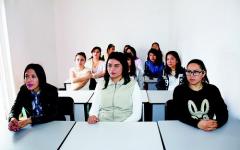In special correctional schools of the VIII type, children with developmental delays are educated and educated. mental development. The main goals of these educational institutions– teach children to read, count, write and navigate social conditions. The efforts of teachers are aimed at correcting and compensating for developmental deviations through education and labor training. Considerable importance is also attached to socio-psychological rehabilitation for subsequent integration into society.
Lesson notes compiled by professional teachers, cool hours and additional classes; The programs and projects they have successfully used for mentally retarded children are collected in this section.
Specific ways of working in correctional classes of type VIII.
Contained in sections:Showing publications 1-10 of 278.
All sections | Correctional school 8 types. (VIII type)
Integrated lesson by a psychologist and speech therapist “Friendship grows stronger every day” in the 3rd grade of the 8th grade school Integrated session with a psychologist and speech therapist. 3rd grade (1 option) school 8 types Theme“Friendship grows stronger every day!” (psychology, speech therapy, reading lesson) Target: forming friendly relationships in the classroom, uniting the children's team. Tasks: 1. Generalize and expand knowledge...
SBO lesson “Types of clothing. Clothes for the intended purpose" in the 7th grade of the 8th type correctional school SBO lesson in 7th grade correctional school 8 types. Subject: “Types of clothing. Clothes for the intended purpose" Target: to form students’ ideas about types and purposes of clothing. Tasks: - correctional and educational : to form students’ knowledge about types of clothing, depending on their...
Correctional school 8 types. (VIII type) - Conversation “Self-massage” for children in grades 1–3 of a correctional school, type 8
Publication “Conversation “Self-massage” for children in grades 1–3 of correctional school 8...” Self-massage. Goal: to create motivation in children for the need to be healthy. Guys, which of you rarely gets sick, raise your hand. And whoever gets sick often, raise your hand too. How do you feel when you are sick? (Headache, throat, ear ache, fever) Which of you like...
Image library "MAAM-pictures"
Summary of a lesson in mathematics in the 8th grade of a correctional school of the VIII type KGBOU "Blagoveshchensk comprehensive boarding school" Topic: "Construction of symmetrical figures relative to the axis of symmetry." Summary of a lesson in mathematics in the 8th grade of a correctional school of the VIII type Prepared by: Nikulina Svetlana Nikolaevna R.p. Annunciation 2018 Lesson summary on...
Summary of a lesson on speech therapy rhythms in the 3rd grade of a correctional school of the VIII type Summary of a speech therapy rhythm lesson in the 3rd grade of a correctional school of the VIII type with elements of rhythmoplasty and psycho-gymnastics teacher speech therapist: Solodukhina S.N. Topic: “Day of the vernal equinox. Larks. Automation of sounds (P) - (Rb).” Goal: Automate the sounds R; Ry in...
 Grade 5 Topic: “Actions with integers and” - adventures in the world of Boring mathematics. Objectives: 1. Generalization and systematization of knowledge on the topic “Actions with integers”; consolidation of skills to work with geometric shapes. 2. Development of switchability and concentration. 3....
Grade 5 Topic: “Actions with integers and” - adventures in the world of Boring mathematics. Objectives: 1. Generalization and systematization of knowledge on the topic “Actions with integers”; consolidation of skills to work with geometric shapes. 2. Development of switchability and concentration. 3....
Correctional school 8 types. (VIII type) - Extra-curricular event “New Year’s Tale” for 2nd grade students of 8th type school
Scenario extracurricular activity“New Year's Tale” for 2nd grade schoolchildren, type 8, option 2. Goal: create a festive atmosphere, teach how to perform in front of an audience. Objectives: 1. Teach children to read poetry expressively, move to the beat of music, teach children to perform in skits and...
 Lesson summary in the 1st grade of school, type 8 Developed by: primary school teacher Elena Leonidovna Bushina Topic: “Number and figure 5” Purpose: To introduce the number and figure 5. To develop the ability to compare numbers within 5. Objectives: Educational: To teach counting within 5 ....
Lesson summary in the 1st grade of school, type 8 Developed by: primary school teacher Elena Leonidovna Bushina Topic: “Number and figure 5” Purpose: To introduce the number and figure 5. To develop the ability to compare numbers within 5. Objectives: Educational: To teach counting within 5 ....
Special educational institutions are designed to educate people with various developmental disabilities. There are eight types of such schools in total. Correctional institutions of the 1st type have been created to educate deaf children. Special schools of the 2nd type are designed to educate children who are hard of hearing, have partial hearing loss and varying degrees of speech underdevelopment. Correctional schools of the 3rd and 4th types are organized for training, education, and correction of developmental deviations and disorders. Such educational institutions accept blind and visually impaired children, children with amblyopia, strabismus, complex combinations of visual impairments, and those suffering from eye diseases leading to blindness.
Correctional schools of the 5th type are intended for children with severe speech pathologies, children with severe general speech underdevelopment, and stuttering. Special educational institutions of the 6th type were created for the training and education of children with any developmental disorders of the musculoskeletal system, with cerebral palsy, and deformities of the musculoskeletal system. Special schools of the 7th type are intended for the education and upbringing of children with mental retardation. With intact intellectual development capabilities, such children experience attention, memory, increased exhaustion, insufficient tempo of mental processes, emotional instability, and lack of formation of voluntary regulation of activity. Corrective educational institutions of the 8th type were created for the training and education of children with mental retardation.
Correctional schools of the 8th type
The purpose of creating special educational institutions of the 8th type is the correction of developmental deviations, as well as socio-psychological rehabilitation for further integration into society. In such schools, classes are created for children with severe mental retardation; the number of people in such classes should not exceed 8 people. Pupils from Type 8 schools have irreversible developmental disorders and will never be able to catch up with their peers, therefore, education in these educational institutions is largely aimed at developing their life competence for adaptation in society, allowing them to avoid disasters social nature. They are given a small amount of academic knowledge, which is used to maintain socialization. Children with intellectual disabilities are educated in a special program until the 9th grade. Those of them who can master a blue-collar profession are subsequently engaged in low-skilled labor.
- intended for children with profound hearing impairment (deafness).
The main task is to teach a deaf child to communicate with others, to master several types of speech: oral, written, tactile, gestural. The curriculum includes courses aimed at compensating for hearing through the use of sound-amplifying equipment, pronunciation correction, social and everyday orientation, and others.
Correctional schools 2 types
- for hearing impaired or late deaf children.
It is aimed at restoring lost hearing abilities, organizing active speech practice, and teaching communication skills.
Correctional schools 3 types
Blind children are accepted, as well as children with visual acuity from 0.04 to 0.08 with complex defects leading to blindness.
Correctional schools 4 types
- for children with visual acuity from 0.05 to 0.4 with the possibility of correction.
The specifics of the defect require training using typhoid equipment, as well as special didactic materials allowing you to assimilate incoming information.
Correctional schools 5 types
-intended for children with general underdevelopment speech, as well as severe speech pathology.
The main goal of the school is the correction of speech defects. The entire educational process is organized in such a way that children have the opportunity to develop speech skills throughout the day. If a speech defect is eliminated, parents have the right to transfer the child to a regular school.
Correctional schools 6 types
- Children with musculoskeletal disorders.
The correctional institution provides restoration of motor functions, their development, and correction of secondary defects. Particular attention is paid to the social and labor adaptation of pupils.
Correctional schools 7 types
- accepts children with mental retardation, and with the potential for intellectual development.
At school, mental development is corrected, development cognitive activity and skills development educational activities. Based on the results of training in primary school pupils can be transferred to a comprehensive school.
Correctional schools 8 types
- children with mental retardation for education under a special program.
The purpose of training is socio-psychological rehabilitation and the possibility of integrating the child into society. In such schools there are classes with in-depth labor training.
More about correctional schools
The vast majority of correctional schools have a high degree of specialization and almost all of the listed types of correctional schools educate children for twelve years and have on their staff specialists such as defectologists, speech therapists, and psychologists.
IN last years Special educational institutions are also being created for other categories of children with disabilities in health and life: with autistic personality traits, with Down syndrome.
There are also sanatorium (forest schools) for chronically ill and weakened children. Special (correctional) educational institutions are financed by the appropriate founder.
Each one is like this educational institution bears responsibility for the life of the pupil and ensuring his constitutional right to receive free education within the limits of the special educational standard.
All children are provided with conditions for training, education, treatment, social adaptation and integration into society.
Graduates of special (correctional) educational institutions (with the exception of type VIII schools) receive a qualified education (i.e. corresponding to the education levels of a mass secondary school: for example, basic general education, general secondary education).
They are issued a state-issued document confirming the level of education received or a certificate of completion of a special (correctional) educational institution.
IN A child’s special school is sent by educational authorities only with the consent of the parents and according to the conclusion (recommendation) of the psychological, medical and pedagogical commission.
Also, with the consent of the parents and on the basis of the conclusion of the PMPC, a child can be transferred within a special school to a class for children with mental retardation only after the first year of study there.
In a special school, a class (or group) can be created for children with a complex structure of defects as such children are identified during psychological, medical and pedagogical observation in the educational process.
In addition, any type of special school may open classes for children with severe mental development disorders and other accompanying disorders. The decision to open such a class is made by the pedagogical council of a special school if the necessary conditions and specially trained personnel are available.
The main tasks of such classes are to provide elementary primary education, create the maximum favorable conditions for the development of the child’s personality, for him to receive pre-professional or basic labor and social training, taking into account his individual capabilities.
A student of a special school may be transferred for study to a regular general education school by educational authorities with the consent of the parents (or persons replacing them) and on the basis of the conclusion of the PMPK, and also if the general education school has the necessary conditions for integrated learning.
Beyond Education special school provides children with limited health and vital functions with medical and psychological support, for which the special school has appropriate specialists on staff.
They work in close cooperation with teaching staff, carrying out diagnostic activities, psychocorrectional and psychotherapeutic measures, maintaining a protective regime in a special school, and participating in career counseling.
If necessary, children receive medication and physiotherapeutic treatment, massage, hardening procedures, and attend physical therapy classes.
The process of social adaptation and social integration is helped by a social teacher. Its role especially increases at the stage of choosing a profession, graduating from school and transitioning to the post-school period.
Each special school pays significant attention to the labor and pre-vocational training of its students. The content and forms of training depend on local characteristics: territorial, ethno-national and cultural, on the needs of the local labor market, the capabilities of students, and their interests. The work profile is chosen purely individually, including preparation for individual work.
For orphans and children left without parental care with special educational needs, special orphanages and boarding schools are created in accordance with the profile of developmental disorders. These are mainly orphanages and boarding schools for children and adolescents with intellectual underdevelopment and learning difficulties.
If a child is unable to attend a special (correctional) educational institution, his education is organized at home.
The organization of such training is determined by Government decree Russian Federation“On approval of the procedure for raising and educating disabled children at home and in non-state educational institutions” dated July 18, 1996 No. 861.
Recently, they have begun to create homeschooling schools, whose staff, consisting of qualified speech pathologists and psychologists, works with children both at home and in the conditions of partial stay of such children in a home-schooling school.
In conditions of group work, interaction and communication with other children, the child masters social skills and gets accustomed to learning in a group or team setting.
The right to study at home is granted to children whose diseases or developmental disabilities correspond to those specified in the special list established by the Ministry of Health of the Russian Federation. The basis for organizing home-based education is a medical report from a medical institution.
A school or preschool educational institution located nearby is involved in providing assistance in educating children at home. During the period of study, the child is given the opportunity to use textbooks and the school library for free.
School teachers and psychologists provide advisory and methodological assistance to parents in their child’s mastery of general education programs.
The school provides intermediate and final certification child and issues a document on the appropriate level of education.
Participating in the certification are: speech pathologists, additionally involved to carry out correctional work.
If a child with special educational needs is educated at home, educational authorities compensate parents for educational expenses in accordance with state and local standards for financing the child’s education in the appropriate type and type of educational institution.
For training, education and social adaptation of children and adolescents with complex and severe developmental disorders, concomitant diseases, and to provide them with comprehensive assistance, rehabilitation centers of various profiles are being created.
These can be centers: psychological - medical - pedagogical rehabilitation and correction; social and labor adaptation and career guidance; psychological, pedagogical and social assistance; special assistance family and children left without parental care, etc.
The task of such centers is to provide correctional pedagogical, psychological and career guidance assistance, as well as to develop self-care and communication skills, social interaction, and work skills in children with severe and multiple disabilities.
A number of centers conduct special educational activities.
Classes in rehabilitation centers are based on individual and individual programs. group education and training. Often, centers provide advisory, diagnostic and methodological assistance to parents of children with special educational needs, including information and legal support. Rehabilitation centers also provide social and former pupils of educational institutions, orphans and children left without parental care.
Rehabilitation centers help mass educational institutions if they educate and educate children with special educational needs: conducting correctional pedagogical work and counseling.
For providing speech therapy assistance preschool children school age For students with speech development disorders in general educational institutions, there is a speech therapy service.
This could be the introduction of a speech therapist position to the staff of an educational institution; the creation of a speech therapy room within the structure of the education management body or the creation of a speech therapy center.
The most widespread form has become a speech therapy center at a general education institution.
Its main tasks: activities are: correction of oral and writing; timely prevention of academic failure caused by speech disorders; dissemination of basic speech therapy knowledge among teachers and parents. Classes on speech therapy center
are carried out both in free time and during lessons (in agreement with the school administration). Children diagnosed with mental retardation and students in special education classes receive speech therapy assistance speech therapist teacher









